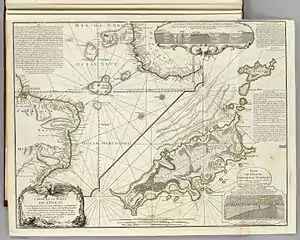Philippe Buache
Philippe Buache (born La Neuville-au-Pont, 7 February 1700; died Paris, 24 January 1773) was a French geographer, known for inventing a new system of geography and popularizing this field.[1]



Life and work
Buache was trained under the geographer Guillaume Delisle, whose daughter he married, and whom he succeeded in the Académie des sciences in 1730.[1]
Buache was nominated first geographer of the king in 1729. He established the division of the world by seas and river systems. He believed in a southern continent, an hypothesis which was confirmed by later discoveries. In 1754, he published an "Atlas physique." He also wrote several pamphlets.
His nephew, Jean Nicolas Buache (born La Neuville-au-Pont, 15 February 1741; died Paris, 21 November 1825), was also a geographer of the king.
Works
- Considérations géographiques et physiques sur les découvertes nouvelles dans la grande mer (Paris, 1754). This contains a chart of the western coast of North America.
- Le parallèle des fleuves des quatre parties du monde pour servir a déterminer la hauteur des montagnes (1757)
- Mémoire sur la traversée de la mer glaciale arctique (1759). This contains his hypothesis of an Alaskan peninsula.
- Considérations géographiques sur les terres australes et antarctiques (1761)
See also
References
- Wilson, J. G.; Fiske, J., eds. (1900). . Appletons' Cyclopædia of American Biography. New York: D. Appleton.
External links
| Wikimedia Commons has media related to Philippe Buache. |
- The French West Indies Collection, including geographical writings of cartographer Philippe Buache, are available for research use at the Historical Society of Pennsylvania.